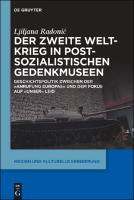| dc.contributor.author | Radonic, Ljiljana | |
| dc.date.accessioned | 2021-11-05T04:02:52Z | |
| dc.date.available | 2021-11-05T04:02:52Z | |
| dc.date.issued | 2021-07 | |
| dc.identifier | OCN: 1272925247 | |
| dc.identifier.isbn | 978-3-11-071481-4 | |
| dc.identifier.uri | https://library.oapen.org/handle/20.500.12657/51274 | |
| dc.description.abstract | Memorial museums are understood as flagships of the respective country’s memory politics – in the context of transnational processes. How do big, publicly (co-)funded memorial museums that (re-)opened after 1989 in the eleven post-Communist EU member states exhibit the World War II period? Beyond a mere overview of the museum and their history the book analyzes how ‚double‘ and ‚tripple‘ occupation, Holocaust, victimhood and collaboration are represented in the permanent exhibitions and which role EU accession talks and authoritarian tendencies played and play in this. | |
| dc.language | German | |
| dc.subject.classification | thema EDItEUR::J Society and Social Sciences::JB Society and culture: general::JBC Cultural and media studies::JBCC Cultural studies | en_US |
| dc.subject.classification | thema EDItEUR::J Society and Social Sciences::JP Politics and government::JPF Political ideologies and movements::JPFQ Far-right political ideologies and movements | en_US |
| dc.subject.classification | thema EDItEUR::J Society and Social Sciences::JP Politics and government::JPS International relations::JPSN International institutions | en_US |
| dc.subject.classification | thema EDItEUR::1 Place qualifiers::1Q Other geographical groupings: Oceans and seas, historical, political etc::1QF Political, socio-economic, cultural and strategic groupings::1QFE EU (European Union) | en_US |
| dc.subject.classification | thema EDItEUR::N History and Archaeology | en_US |
| dc.subject.classification | thema EDItEUR::3 Time period qualifiers::3M c 1500 onwards to present day::3MP 20th century, c 1900 to c 1999::3MPQ Later 20th century c 1950 to c 1999 | en_US |
| dc.subject.classification | thema EDItEUR::3 Time period qualifiers::3M c 1500 onwards to present day::3MR 21st century, c 2000 to c 2100 | en_US |
| dc.subject.classification | thema EDItEUR::N History and Archaeology::NH History::NHT History: specific events and topics::NHTZ Genocide and ethnic cleansing::NHTZ1 The Holocaust | en_US |
| dc.subject.classification | thema EDItEUR::N History and Archaeology::NH History::NHW Military history::NHWR Specific wars and campaigns::NHWR7 Second World War | en_US |
| dc.subject.classification | thema EDItEUR::1 Place qualifiers::1D Europe | en_US |
| dc.subject.classification | thema EDItEUR::3 Time period qualifiers::3M c 1500 onwards to present day::3MP 20th century, c 1900 to c 1999::3MPB Early 20th century c 1900 to c 1950::3MPBL c 1940 to c 1949 | en_US |
| dc.subject.classification | thema EDItEUR::N History and Archaeology::NH History::NHW Military history::NHWL Modern warfare | en_US |
| dc.subject.classification | thema EDItEUR::3 Time period qualifiers::3M c 1500 onwards to present day::3MP 20th century, c 1900 to c 1999::3MPB Early 20th century c 1900 to c 1950::3MPBL c 1940 to c 1949::3MPBLB c 1938 to c 1946 (World War Two period) | en_US |
| dc.subject.other | Memorial Museums; Post-Communist Transformation; World War II; Europeanization of Memory; Universalization of the Holocaust; Memory Politics | en |
| dc.subject.other | ÖFOS 2012, Political Science | en |
| dc.subject.other | ÖFOS 2012, Cultural studies | en |
| dc.subject.other | ÖFOS 2012, Contemporary history | en |
| dc.subject.other | Gedenkmuseen; postsozialistische Transformationsprozesse; Zweiter Weltkrieg; Europäisierung der Erinnerung; Universalisierung des Holocaust; Geschichtspolitik | de |
| dc.subject.other | ÖFOS 2012, Politikwissenschaften | de |
| dc.subject.other | ÖFOS 2012, Kulturwissenschaft | de |
| dc.subject.other | ÖFOS 2012, Zeitgeschichte | de |
| dc.title | Der Zweite Weltkrieg in postsozialistischen Gedenkmuseen: Geschichtspolitik zwischen der ‚Anrufung Europas‘ und dem Fokus auf ‚unser‘ Leid | de |
| dc.type | book | |
| dc.type | book | |
| oapen.abstract.otherlanguage | Im Vordergrund der Studie steht das Gedenkmuseum als Flaggschiff der Geschichtspolitik des jeweiligen Landes im Kontext transnationaler Prozesse. Wie wird die Zeit des Zweiten Weltkriegs in großen, öffentlich (mit )finanzierten Gedenkmuseen, die nach 1989 (wieder )eröffnet wurden, in den elf ‚osteuropäischen‘ EU-Mitgliedsländern repräsentiert? Über den Überblick über die Museen und ihre Entstehungsgeschichte hinausgehend wurde untersucht, wie ‚doppelte‘ bzw. ‚dreifache‘ Okkupation und der Holocaust, Opfernarrative und Kollaboration in den ständigen Ausstellungen verhandelt werden und welche Auswirkungen die EU-Beitrittsbemühungen und autoritäre Tendenzen auf dieses Aushandeln hatten und haben. | |
| oapen.relation.isPublishedBy | De Gruyter | |
| oapen.relation.isFundedBy | 0bdd30b8-28cc-4e2d-bd69-6cabb77b36d4 | |
| oapen.collection | Austrian Science Fund (FWF) | |
| oapen.imprint | De Gruyter | |
| oapen.grant.number | PUB 863 | |

